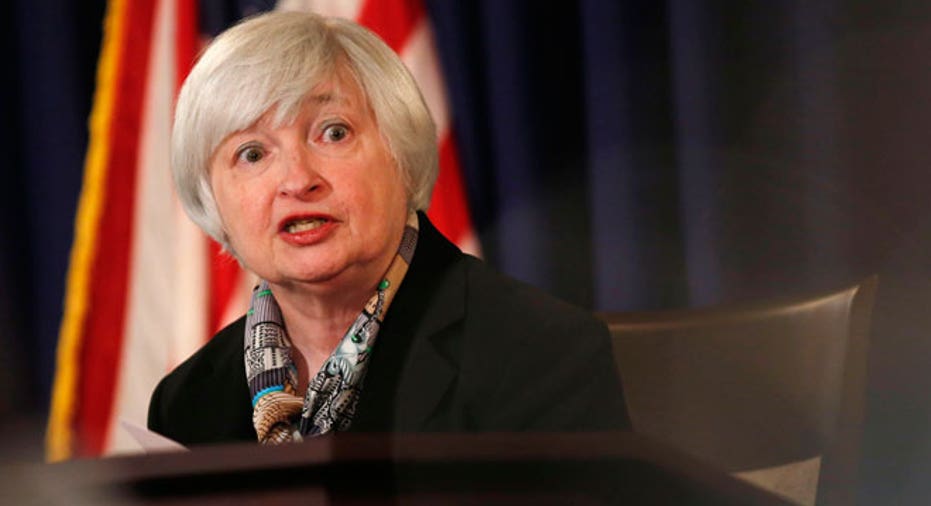Fed Rate Hike Clock May Start Ticking Today

The clock is expected to start ticking Wednesday toward higher interest rates.
The Federal Reserve, in all likelihood, will remove from its meeting statement the phrase “for a considerable period,” language that, for months, has been used to reassure markets that rates will stay low for an indeterminate period of time beyond the end of the Fed’s bond-buying program, which was shut down in October.
The general consensus among economists and analysts has been that “for a considerable period” has meant about six months, which means that if the language is removed Wednesday, rates should start moving higher in mid-2015.
The policy-setting Federal Open Market Committee will conclude its two-day meeting Wednesday with the release of the statement at 2 p.m ET., followed by a press conference with Fed Chair Janet Yellen.
The Fed has said it won’t raise rates until it meets its dual mandate of full employment and price stability, which it describes respectively as an unemployment rate in a range of 5.2%-5.6% and inflation at a range of 1.7%-2%.
The unemployment rate, currently at 5.8%, its lowest level in six years, is well on its way to reaching the desired range, but inflation has been more problematic, running much lower than the Fed’s 2% target rate for months, mostly due to stagnant U.S. wages.
But rapidly falling oil prices have recently put even more downward pressure on inflation as a barrel of oil has fallen well-below $60, driving down the price of gasoline across the U.S. The price of oil has fallen sharply since June, dropping to levels not seen since 2009, amid mounting supplies and concerns for a global economic slowdown that would cut into demand.
A Likely Scenario
This is likely a temporary event, however, and not expected to impact the Fed’s long-term thinking.
Ahead of Wednesday’s statement, analysts at IHS Global Insight laid out a likely scenario for how the Fed will telegraph its next move:
“The next step is to change its forward rate guidance as a signal that rate hikes are coming. Indeed, the Fed is striving to avoid any unpleasant market surprises. The best way to accomplish this, and one advocated by a number of policymakers, is to drop the language in the policy statement pledging to keep interest rates low for a “considerable time” after bond purchases end,” the analysts said.
The IHS analysts concur with the consensus opinion that rates will probably start moving higher after the Fed’s June 2015 meeting. Consequently, today’s meeting is “an opportune time” to change the statement language because Yellen will have an opportunity to explain the move at her press conference.
So despite the recent downward pressure on inflation, the IHS analysts believe the Fed will start preparing markets for higher rates today.
“We believe that it is probable, though not certain, that the Fed will drop the ‘considerable time’ language from the statement, though perhaps replace it with a pledge to proceed ‘patiently’ or ‘cautiously.’”
Markets Don’t Like Surprises
Yellen and her dovish FOMC colleagues have been reluctant to strip away all of the Fed-initiated stimulus that has pumped cash into the economy since the 2008 financial crisis. Raising interest rates will make it more expensive for consumers and businesses to borrow money, raising the costs on everything from a mortgage to a car loan. And it will cost businesses more to borrow for capital improvements and expansion, which could cut into hiring.
For these reasons the Fed has held off on interest rate hikes, waiting until an array of economic indicators suggest that the economy is healthy enough for such a move.
Meanwhile, on the other side of the monetary policy spectrum, inflation hawks have advocated moving up the time-table for raising rates in an effort to ward off runaway inflation and potentially dangerous asset bubbles caused by all the free-flowing stimulus money.
That argument has been mostly held at bay by the stubbornly-low inflation rate. However, if inflation starts to pick up due to rising U.S. wages and a tightening U.S. labor market, the doves might reconsider their cautious approach toward lifting rates.
But that’s unlikely. The Fed doesn’t like surprises because markets don’t like surprises, which means the Fed will almost certainly stick to a mid-2015 liftoff schedule unless something extraordinary happens between now and then.



















